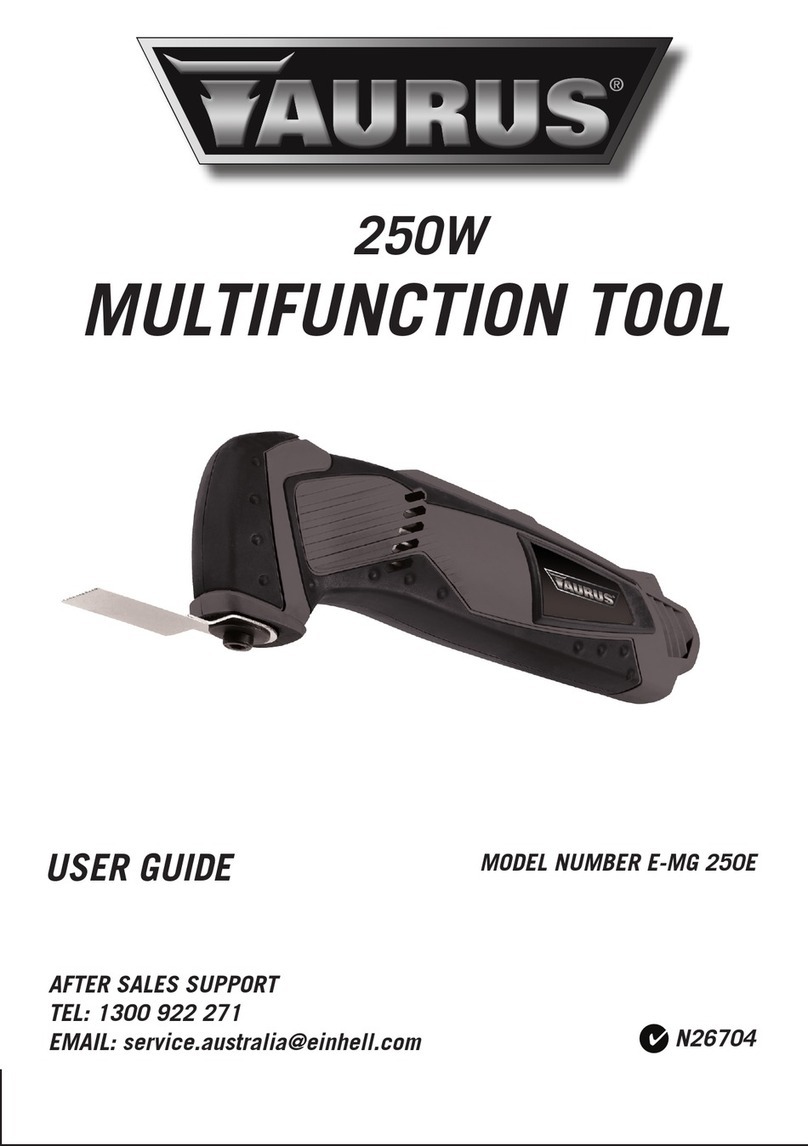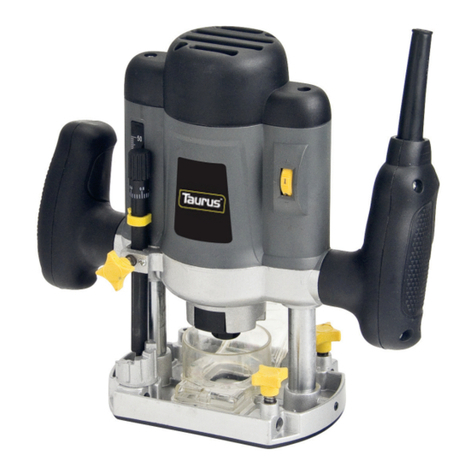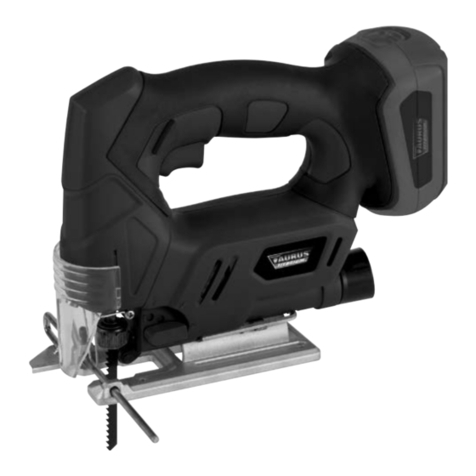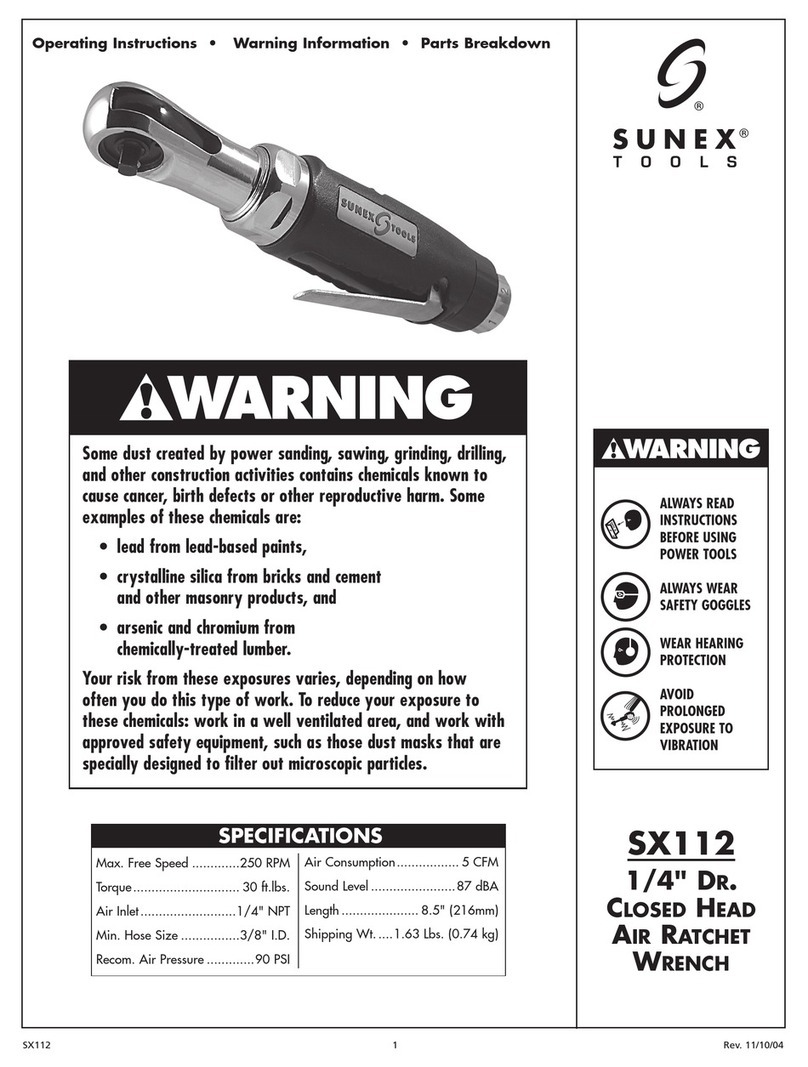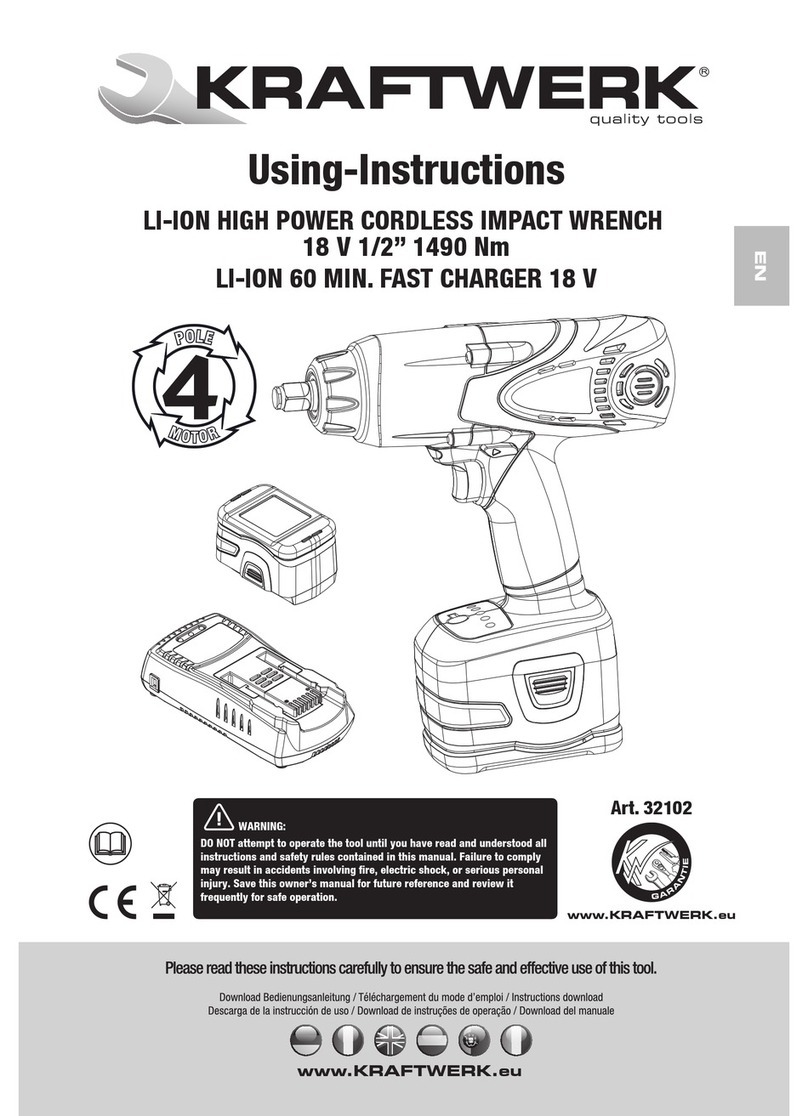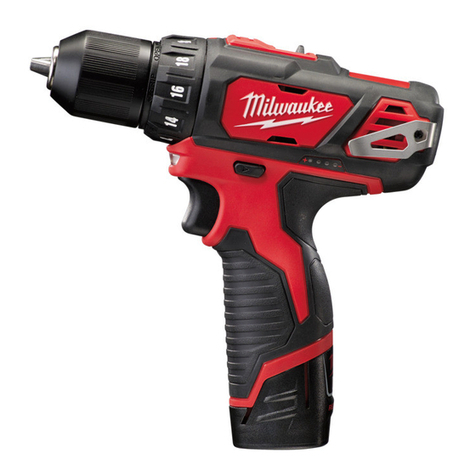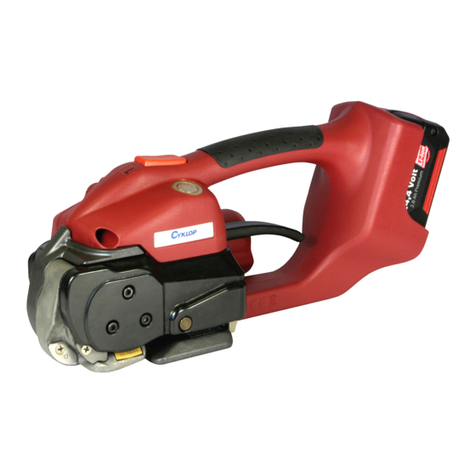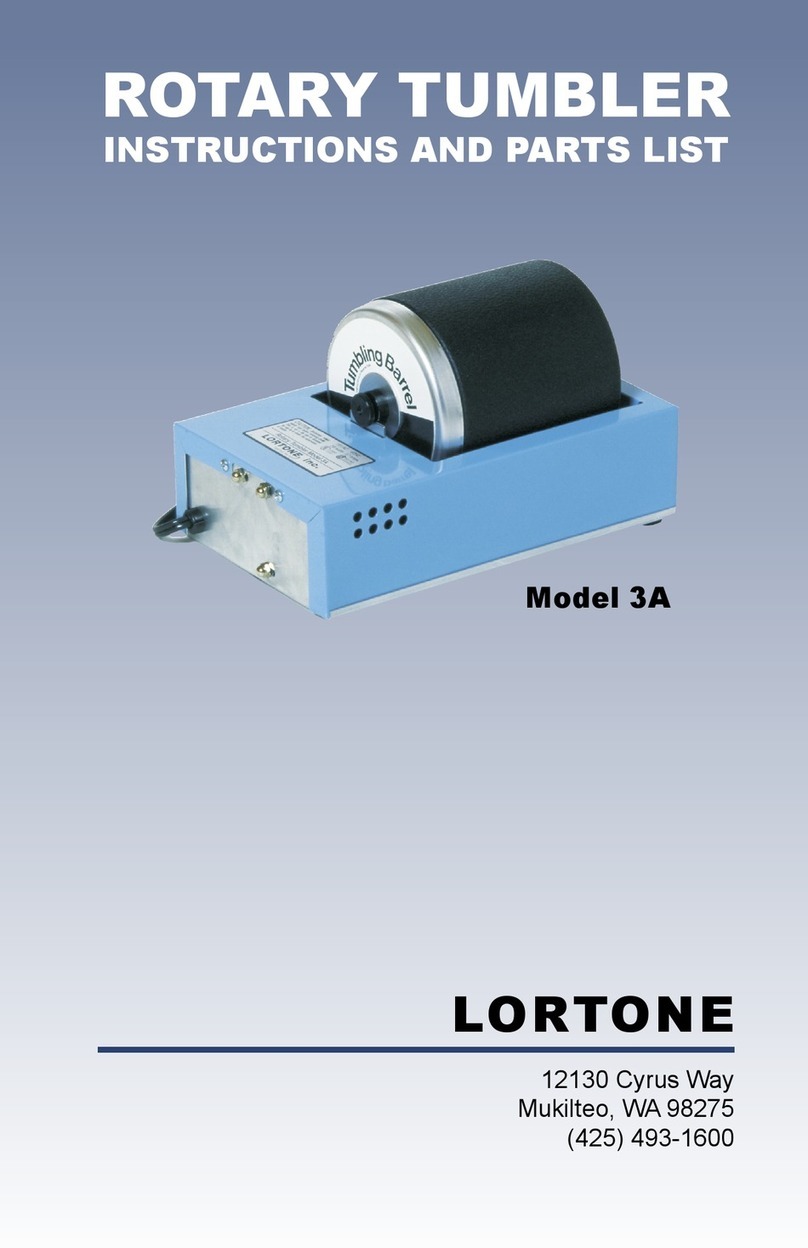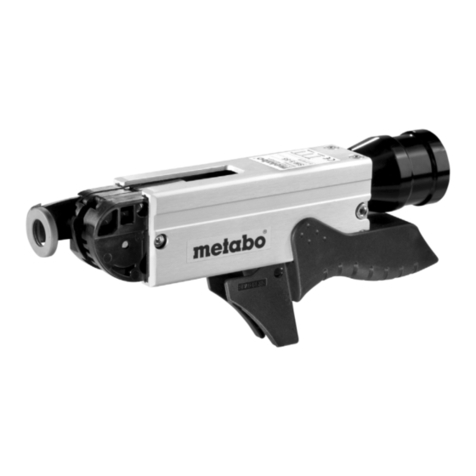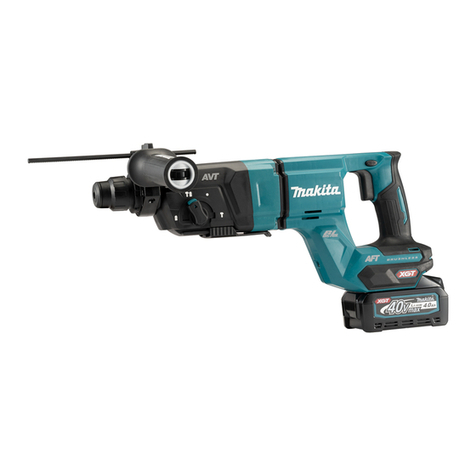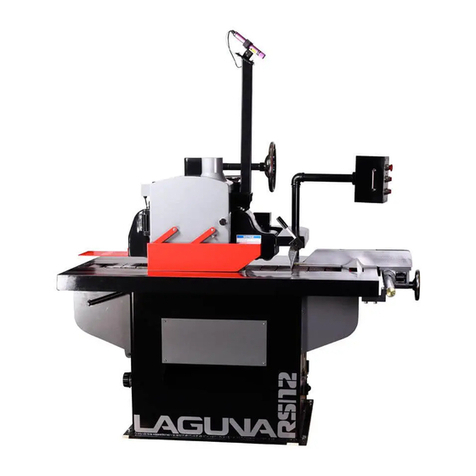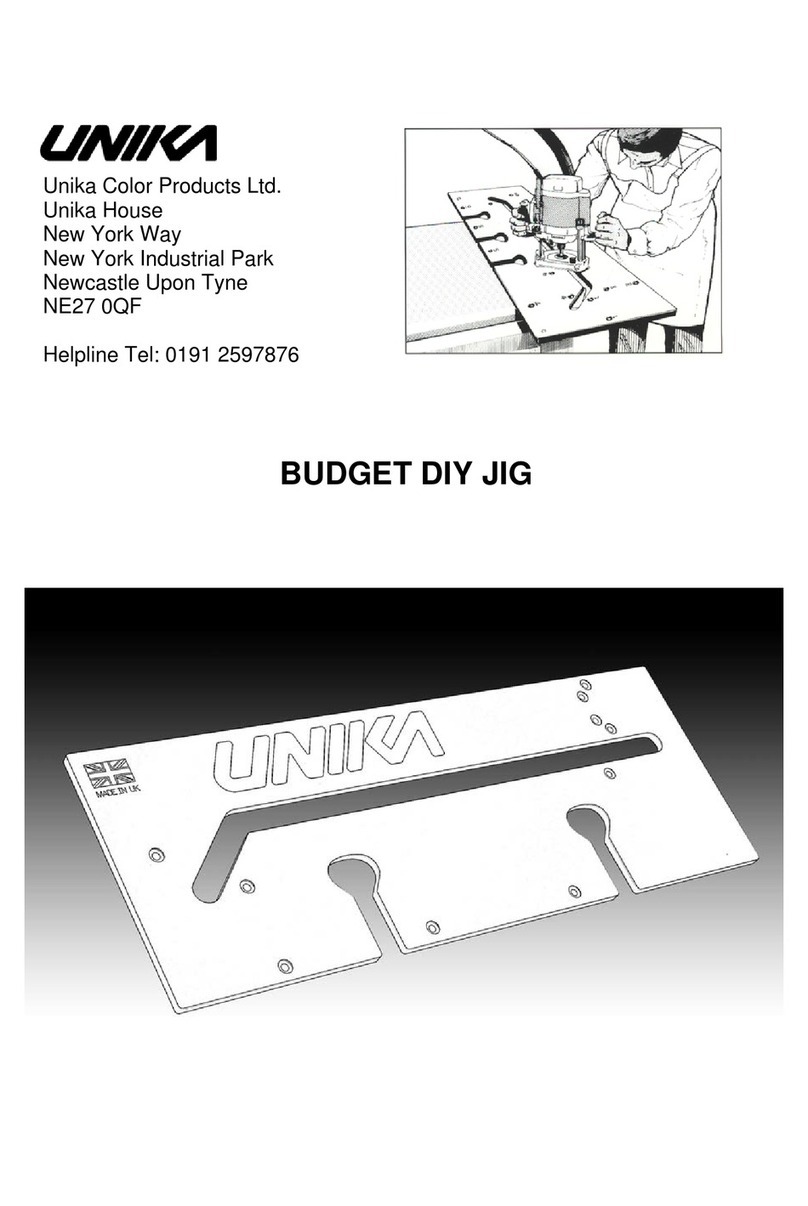Taurus BT-CK 18 2B-1.5 Kit User manual

LI-ION 18V
POWER TOOL SET 5PC
N26704
INSTRUCTION MANUAL
AFTER SALES SUPPORT
TEL: 1300 922 271
EMAIL: [email protected]
MODEL NUMBER BT-CK 18 2B-1.5 Kit

1
POWER TOOL SET 5PC
What your 3year warranty means
Great care has gone into the manufacture of these products and they should therefore provide you with years
of good service when used properly. In the event of product failure within its intended use over the course
of the rst 3year after the date of purchase, we will remedy the problem as quickly as possible once it has been
brought to our attention. In the unlikely event of such an occurrence, or if you require any information about
the product, please contact us via our after sales support services, details of which can be found in this manual
and on the product itself.
Welcome Section
Congratulations on choosing to buy a TAURUS TITANIUM® product.
All products brought to you by TAURUS TITANIUM® are manufactured to the highest standards of performance
and safety, and, as part of our philosophy of customer service and satisfaction, are backed by our
comprehensive 3Year Warranty.
We hope you will enjoy using your purchase for many years to come.
Table of Contents
1. General Safety Rules
2. Battery Safety Rules
3. Charger Operating Instruction
3.1. Charger Safety Rules
3.2. Layout
3.3. Technical data
3.4. Operation
3.5. Cleaning and maintenance
3.6. Disposal and recycling
4. Cordless Drill Operating Instructions
4.1. Cordless Drill Safety Rules
4.2. Layout/Items Supplied
4.3. Proper Use
4.4. Technical data
4.5. Before starting the equipment
4.6. Operation
4.7. Cleaning, maintenance and ordering of spare parts
4.8. Disposal and recycling
Pg. 4
Pg. 5
Pg 7
Pg. 8
Pg. 8
Pg. 8
Pg. 8
Pg. 9
Pg. 9
Pg. 10
Pg. 12
Pg. 12
Pg. 12
Pg. 12
Pg. 13
Pg. 13
Pg. 14

2
4.9 Storage
5. Cordless Circular Saw Operating Instructions
5.1. Cordless Circular Saw Safety Rules
5.2. Layout/Items Supplied
5.3. Proper Use
5.4. Technical data
5.5. Before starting the equipment
5.6. Operation
5.7. Cleaning, maintenance and ordering of spare parts
5.8. Disposal and recycling
5.9 Storage
6. Cordless Jigsaw Operating Instructions
6.1. Cordless Jigsaw Safety Rules
6.2. Layout/Items Supplied
6.3. Proper Use
6.4. Technical data
6.5. Before starting the equipment
6.6. Operation
6.7. Cleaning, maintenance and ordering of spare parts
6.8. Disposal and recycling
6.9 Storage
7. Cordless Reciprocating Saw Operating Instructions
7.1. Cordless Reciprocating Safety Rules
7.2. Layout/Items Supplied
7.3. Proper Use
7.4. Technical data
7.5. Before starting the equipment
7.6. Operation
7.7. Cleaning, maintenance and ordering of spare parts
7.8. Disposal and recycling
7.9 Storage
8. Cordless Lamp Operating Instructions
8.1. Cordless Lamp Safety Rules
8.2. Layout/Items Supplied
8.3. Technical data
8.4. Before starting the equipment
Pg. 14
Pg. 14
Pg. 15
Pg. 18
Pg. 19
Pg. 19
Pg. 20
Pg. 20
Pg. 21
Pg. 22
Pg. 22
Pg. 22
Pg. 23
Pg. 25
Pg. 26
Pg. 26
Pg. 26
Pg. 27
Pg. 27
Pg. 28
Pg. 29
Pg. 29
Pg. 30
Pg. 31
Pg. 31
Pg. 32
Pg. 32
Pg. 32
Pg. 33
Pg. 33
Pg. 33
Pg. 33
Pg. 34
Pg. 36
Pg. 36
Pg. 36

3
8.5. Operation
8.6. Cleaning, maintenance and ordering of spare parts
8.7. Disposal and recycling
8.8. Storage
Pg. 36
Pg. 36
Pg. 36
Pg. 37
Pg. 37

4
plugging in power tools that have the switch
on invites accidents.
d. Remove any adjusting key or wrench before
turning the power tool on. A wrench or a key left
attached to rotating part of the power tool may
result in personal injury.
e. Do not overreach. Keep proper footing and
balance at all times. This enables better control
of the power tool in unexpected situations.
f. Dress properly. Do not wear loose clothing or
jewellery. Keep your hair, clothing and gloves
away from moving parts. Loose clothes,
jewellery or long hair can be caught in moving
parts.
g. If devices are provided for the connection of
dust extraction and collection facilities, ensure
these are connected and properly used. Use of
these devices can reduce dust-related hazards.
4. Power tool use and care
a. Do not force the power tool. Use the correct
power tool for your application. The correct
power tool will do the job better and safer at the
rate for which it was designed.
b. Do not use the power tool if the switch does not
turn it on and o. Any power tool that cannot be
controlled with the switch is dangerous and must
be repaired.
c. Disconnect the plug from the power source
and/ or the battery pack from the power tool
before making any adjustments, changing
accessories, or storing power tools. Such
preventive safety measures reduce the risk
of starting the power tool accidentally.
d. Store idle power tools out of the reach of
children and do not allow persons unfamiliar
with the power tool or these instructions to
operate the power tool. Power tools are
dangerous in the hands of untrained users.
e. Maintain power tools. Check for misalignment
or binding of moving parts, breakage of parts
and any other condition that may aect the
power tools operation. If damaged, have the
power tool repaired before use. Many accidents
are caused by poorly maintained power tools.
f. Keep cutting tools sharp and clean. Properly
maintained cutting tools with sharp cutting
edges are less likely to bind and are easier to
control.
g. Use the power tool, accessories and tool bits
etc. in accordance with these instructions and
in the manner intended for the particular type
of power tool, taking into account the working
conditions and the work to be performed. Use
of the power tool for operations dierent from
those intended could result in a hazardous
situation.
5. Service
a. Have your power tool serviced by a qualied
repair person using only identical replacement
parts. This will ensure that the safety of the power
tool is maintained.
6. Recommendation
We recommend that the tool always be supplied
via a residual current device with a rated residual
current of 30mA or less.
1. GENERAL SAFETY RULES
WARNING! Read all instructions. Failure to
follow all instructions listed below may result
in electric shock, re and/or serious injury. The
term ’’power tool’’ in all of the warnings listed
below refers to your mains-operated (corded)
power tool or battery-operated (cordless) power
tool.
SAVE THESE INSTRUCTIONS
1. Work area
a. Keep work area clean and well lit. Cluttered and
dark areas invite accidents.
b. Do not operate power tools in explosive
atmospheres, such as in the presence of
ammable liquids, gases or dust. Power tools
create sparks which may ignite the dust or fumes.
c. Keep children and bystanders away while
operating a power tool. Distractions can cause
you to lose control.
2. Electrical safety
a. Power tools plugs must match the outlet.
Never modify the plug in any way. Do not use
any adapter plugs with earthed (grounded)
power tool. Unmodied plugs and matching
outlets will reduce risk of electric shock.
b. Avoid body contact with earthed or grounded
surfaces such as pipes, radiators, ranges and
refrigerators. There is an increased risk of electric
shock if your body is earthed or grounded.
c. Do not expose power tools to rain or wet
conditions. Water entering a power tool will
increase the risk of electric shock.
d. Do not abuse the cord. Never use the cord
for carrying, pulling or unplugging the power
tool. Keep cord away from heat, oil, sharp edges
or moving parts. Damaged or entangled cords
increase the risk of electric shock.
e. When operating a power tool outdoors, use an
extension cord suitable for outdoor use. Use of
a cord suitable for outdoor use reduces the risk
of electric shock.
f. If operating a power tool in a damp location is
unavoidable, use a residual current device (RCD)
protected supply. Use of an RCD reduces the risk of
electric shock.
3. Personal safety
a. Stay alert, watch what you are doing and use
common sense when operating a power tool.
Do not use a power tool while you are tired or
under the inuence of drugs, alcohol or
medication. A moment of inattention while
operating power tools may result in serious
personal injury.
b. Use safety equipment. Always wear eye
protection. Safety equipment such as dust
mask, non-skid safety shoes, hard hat, or hearing
protection used for appropriate conditions will
reduce personal injuries.
c. Avoid accidental starting. Ensure the switch is in
the o-position before plugging in. Carrying
power tools with your nger on the switch or

5
2. BATTERY SAFETY RULES
Battery tool use and care
a) Recharge only with the charger specied by the
manufacturer. A charger that is suitable for one type of
battery pack may create a risk of re when used with another
battery pack.
b) Use power tools only with specically designated battery
packs. Use of any other battery packs may create a risk of
injury and re.
c) When battery pack is not in use, keep it away from other
metal objects, like paper clips, coins, keys, nails, screws
or other small metal objects, that can make a connection
from one terminal to another. Shorting the battery terminals
together may cause burns or a re.
d) Under abusive conditions, liquid may be ejected from
the battery; avoid contact. If contact accidentally occurs,
ush with water. If liquid contacts eyes, additionally seek
medical help. Liquid ejected from the battery may cause
irritation or burns.
Additional safety instructions
We pay a great deal of attention to the design of every
battery pack to ensure that we supply you with batteries
which feature maximum power density, durability and
safety. The battery cells have a wide range of safety devices.
Each individual cell is initially formatted and its electrical
characteristic curves are recorded. This data is then used
exclusively to be able to assemble the best possible battery
packs. Despite all the safety precautions, caution must
always be exercised when handling batteries. The following
points must be obeyed at all times to ensure safe use.
Safe use can only be guaranteed if undamaged cells are
used. Incorrect handling can cause cell damage.
Important: Analyses conrm that incorrect use and poor
care are the main causes of the damage caused by high
performance batteries.
Information about the battery
1. The battery pack supplied with your cordless tool is not
charged. The battery pack has to be charged before you
use the tool for the rst time.
2. For optimum battery performance avoid low discharge
cycles. Charge the battery pack frequently.
3. Store the battery pack in a cool place, ideally at 15°C and
charged to at least 40%.
4. Lithium-ion batteries are subject to a natural ageing
process. The battery pack must be replaced at the latest
when its capacity falls to just 80% of its capacity when
new. Weakened cells in an aged battery pack are no
longer capable of meeting the high power requirements
and therefore pose a safety risk.
5. Do not throw battery packs into an open re. There is a
risk of explosion!
6. Do not ignite the battery pack or expose it to re.
7. Do not exhaustively discharge batteries. Exhaustive
discharge will damage the battery cells. The most
common cause of exhaustive discharge is lengthy
storage or non-use of partly discharged batteries. Stop
working as soon as the performance of the battery falls
noticeably or the electronic protection system triggers.
Place the battery pack in storage only after it has been
fully charged.
8. Protect batteries and the tool from overloads. Overloads
will quickly result in overheating and cell damage inside
the battery housing without this overheating actually
being apparent externally.
9. Avoid damage and shocks.
Replace batteries which have been dropped from a height
of more than one meter or which have been exposed to
violent shocks without delay, even if the housing of the
battery pack appears to be undamaged. The battery cells
inside the battery may have suered serious damage.
In this respect, please also read the waste disposal
information.
10. If the battery pack suers overloading and overheating,
the integrated protective cut-o will switch o the
equipment for safety reasons.
Important. Do not press the ON/OFF switch any more if
the protective cut-o has actuated. This may damage the
battery pack.
11. Use only original battery packs. The use of other batteries
may result in injuries, explosion and a re risk.
Information on chargers and the charging process
1. Please check the data marked on the rating plate of the
battery charger. Be sure to connect the battery charger
to a power supply with the voltage marked on the rating
plate. Never connect it to a dierent mains voltage.
2. Protect the battery charger and its cable from damage
and sharp edges. Have damaged cables repaired without
delay by a qualied electrician.
3. Keep the battery charger, batteries and the cordless tool
out of children’s reach.
4. Do not use damaged battery chargers.
5. Do not use the supplied battery charger to charge other
cordless tools.
6. In heavy use the battery pack will become warm. Allow
the battery pack to cool to room temperature before
commencing with the charging.
7. Do not over-charge batteries.
Do not exceed the maximum charging times. These
charging times only apply to discharged batteries.
Frequent insertion of a charged or partly charged battery
pack will result in overcharging and cell damage. Do not
leave batteries in the charger for days on end.

6
8. Never use or charge batteries if you suspect that the
last time they were charged was more than 12 months
previously. There is a high probability that the battery
pack has already suered dangerous damage (exhaustive
discharge).
9. Charging batteries at a temperature below 10°C will cause
chemical damage to the cell and may cause a re.
10. Do not use batteries which have heated during the
charging process, as the battery cells may have suered
dangerous damage.
11. Do not use batteries which have suered curvature
or deformation during the charging process or which
show other non-typical symptoms (gassing, hissing,
cracking,…)
12. Never fully discharge the battery pack (recommended
depth of discharge max. 80%) A complete discharge of
the battery pack will lead to premature ageing of the
battery cells.
13. Never charge the batteries unsupervised.
Protection from environmental inuences
1. Wear suitable work clothes. Wear safety goggles.
2. Protect your cordless tool and the battery charger from
moisture and rain. Moisture and rain can cause dangerous
cell damage.
3. Do not use the cordless tool or the battery charger near
vapors and inammable liquids.
4. Use the battery charger and cordless tools only in dry
conditions and an ambient temperature of 10–40°C.
5. Do not keep the battery charger in places where the
temperature is liable to reach over 40°C. In particular, do
not leave the battery charger in a car that is parked in
the sun.
6. Protect batteries from overheating.
Overloads, over-charging and exposure to direct sunlight
will result in overheating and cell damage. Never charge
or work with batteries which have been overheated –
replace them immediately if possible.
7. Storage of batteries, battery chargers and cordless
tools. Store the charger and your cordless tool only in
dry places with an ambient temperature of 10-40°C.
Store your lithium-ion battery pack in a cool, dry place at
a temperature of 10-20°C. Protect them from humidity
and direct sunlight. Only place fully charged batteries in
storage (charged at least 40%).
8. Prevent the lithium-ion battery pack from freezing.
Battery packs which were stored below 0°C for more
than 60 minutes must be disposed of. 9. When handling
batteries beware of electrostatic charge: Electrostatic
discharges cause damage of the electronic protection
system and the battery cells. Avoid electrostatic charging
and never touch the battery poles.
Disposal of batteries
Batteries contain substances harmful to the environment.
Never place batteries in your household refuse, in re or in
water. Batteries should be collected, recycled or disposed of
in an environmentally friendly way. Seek advice on correct
disposal from local waste authorities.
When shipping or disposing of batteries and cordless tools,
always ensure that they are packed individually in plastic
bags to prevent short circuits and res.
Do not lose this safety information.

7
1
2
2 3
234
1a
b
c
1.
2.
3. CHARGER OPERATING INSTRUCTIONS

8
For use in dry rooms only
Safety Class II
Output connector of the charging unit (direct
current): The outer part of the connector is the
negatice pole and the inner part is the positive pole.
If the temperature of the charging unit rises
above 130oC, the overtemperature cut-out will be
activated. The supply of current to the output is
then interrupted.
Caution – Read the operating instructions to reduce
the risk of injury
3.1 CHARGER SAFETY RULES
CAUTION!
Read all safety regulations and instructions.
Any errors made in following the safety regulations and
instructions may result in an electric shock, re and/or serious
injury.
Keep all safety regulations and instructions in a safe place
for future use.
a) The charging unit is not allowed to be used for non-
rechargeable, normal batteries.
b) Sucient ventilation is required.
c) The current and voltage information on the battery pack
must be the same as that on the charging unit.
d) Do not expose the charging unit to water or rain.
e) Do not throw old or damaged batteries into water or re.
Follow the environmental protection directives.
f) A defective or no longer chargeable battery must
be treated as special waste. Dispose of it at a special
collection point. Do not dispose of it with your normal
household waste or throw it into water or re.
g) Place the charging unit away from all sources of heat.
h) To reduce the risk of electric shock, pull the power plug
out of the socket outlet by the plug itself and not by the
cable when you want to disconnect the charging unit
from the power supply.
i) Do not take the charging unit apart. Take it to an
authorized repair center if servicing or repairs are needed.
Incorrect assembly can result in an electric shock, re or
even death.
j) This equipment is not designed to be used by people
(including children) with limited physical, sensory or
mental capacities or those with no experience and/
or knowledge unless they are supervised by a person
who is responsible for their safety or they have received
instructions from such a person in how to use the
equipment safely.
k) Children must always be supervised in order to ensure
that they do not play with the equipment.
3.2 LAYOUT FIG. 1+3
1. 1 hour charger
2. Battery pack
3. ON/OFF button for Battery capacity indicator
4. Battery capacity indicator
3.3. TECHNICAL DATA
Charging unit:
Input: 240V~50Hz, 50W
Output: 21V d.c., 1800mA
Lithium-ion battery:
Cell voltage: 18 Vd.c.
Number of cells: 5
Battery capacity 1,500 mAh
3.4 OPERATION FIG. 1+2
3.4.1 Charging the Li-Ion battery pack (Fig. 1-2)
1. Press the pushlock button (c) and pull the battery pack (2)
out of the equipment as shown in Fig. 2.
2. Check that your mains voltage is the same as that
marked on the rating plate of the battery charger. Insert
the power plug of the charger (1) into the mains socket
outlet. The green LED (a) will then begin to ash.
3. Insert the battery pack into the charger. The red LED (b)
will light up to indicate that the battery pack is being
charged. When the charging is nished, the green LED (a)
will shine with a steady light. Discharged battery packs
require approx. 1 hour for charging. The temperature of
the battery may rise slightly during the charging. This is
normal.
If both LEDs (a, b) ash after the battery pack has been
inserted, the battery pack is defective. In this case pull out
the charger plug immediately and remove the defective
battery pack. Do not use the defective battery pack again.
If both LEDs (a, b) light up after the battery pack has been
inserted, the charging temperature is either low or too
high. In this case, pull out the mains plug of the charger
and charge the battery in an environment in which the
temperature is either warmer or colder.
If the battery fails to charge, please check
• whether there is voltage at the socket outlet
• whether there is good contact at the charging contacts of
the charging unit
130˚

9
If the battery still fails to charge, please call our customer
service on 1300 922 271.
Timely recharging of the battery will help it serve you well for
a long time. You must recharge the battery when you notice
that the power of the cordless product drops.
3.4.2 Battery capacity indicator (Fig. 3/Item 4)
Press the button for the battery capacity indicator (3). The
battery capacity indicator (4) indicates the charge state of the
battery on 3 colored LEDs.
All LEDs illuminate:
The battery is fully charged.
The yellow and red LED illuminate:
The battery has an adequate remaining charge.
Red LED illuminates:
The battery is empty, recharge the battery.
3.5 CLEANING AND
MAINTENANCE
Always pull out the power plug before starting any cleaning
work.
The equipment is not allowed to be stored in a damp location
or where there are caustic gases. Keep it in a dry place out of
the reach of children.
3.5.1 Cleaning
Keep the surface of the equipment clean and wipe it only
with a dry cloth.
3.5.2 Maintenance
There are no other parts inside the equipment which require
maintenance.
The equipment is not allowed to be taken apart. If the
equipment is damaged, contact your supplier or the
manufacturer.
3.6. DISPOSAL AND RECYCLING
The equipment is supplied in packaging to prevent it from
being damaged in transit. The raw materials in this packaging
can be reused or recycled. The equipment and its accessories
are made of various types of material, such as metal and
plastic. Defective components must be disposed of as special
waste. Ask your local council.

10
2
1
7
16
2
3
2 3
4
4
5
1
6
2
1
4. CORDLESS DRILL OPERATING INSTRUCTIONS

12
Caution - Read the operating instructions to reduce
the risk of injury
Wear ear-mus.
The impact of noise can cau se damage to hearing.
Wear a breathing mask.
Dust which is injurious to health can be generated
when working on wood and other materials.
Never use the device to work on any materials
containing asbestos!
Wear Safety goggles.
Sparks generated during working or splinters, chips
and dust emitted by the device can cause loss of
sight.
Change the gear only when the drill is at a standstill.
If you fail to observe this point, the gearing may be
damaged.
4.1. CORDLESS DRILL SAFETY
RULES
CAUTION!
Read all safety regulations and instructions.
Any errors made in following the safety regulations and
instructions may result in an electric shock, re and/or serious
injury.
Keep all safety regulations and instructions in a safe place
for future use.
Hold the equipment by the insulated handles when
carrying out work during which the screw or the plug-in
tool could strike concealed power cables. Contact with a live
cable may also make the metal parts of the equipment live
and cause an electric shock.
4.2. LAYOUT / ITEMS SUPPLIED
FIG. 1/2
4.2.1 Layout
1. Torque selector
2. Forward/Reverse switch
3. ON/OFF switch
4. Battery pack
5. Pushlock button
6. Selector switch for 1st gear to 2nd gear
7. Quick-change drill chuck
4.2.2 Items supplied
• Open the packaging and take out the equipment with
care.
• Remove the packaging material and any packaging and/
or transportation braces (if available).
• Check to see if all items are supplied.
• Inspect the equipment and accessories for transport
damage.
• If possible, please keep the packaging until the end of the
guarantee period.
IMPORTANT
The equipment and packaging material are not toys. Do not
let children play with plastic bags, foils or small parts. There
is a danger of swallowing or suocating!
• Cordless Drill
• Original operating instructions
• Charger (1 x in set included)
• Battery Pack (2 x in set included)
4.3. PROPER USE
The cordless drill is designed for tightening and undoing
screws, as well as for drilling in wood, metal and plastic.
The equipment is to be used only for its prescribed purpose.
Any other use is deemed to be a case of misuse. The user
/ operator and not the manufacturer will be liable for any
damage or injuries of any kind caused as a result of this.
Please note that our equipment has not been designed
for use in commercial, trade or industrial applications. Our
warranty will be voided if the machine is used in commercial,
trade or industrial businesses or for equivalent purposes.
4.4. TECHNICAL DATA
Voltage supply 18 V d.c.
Idling speed: 0-400/0-1150 rpm
Torque settings: 25+1
Forward and reverse rotation yes
Chuck capacity 1–13 mm
Weight 1.2 kg
Max. screw diameter: 6 mm
Sound and vibration
Sound and vibration values were measured in accordance
with EN 60745.
LpA sound pressure level 76 dB(A)
KpA uncertainty 3 dB
LWA sound power level 87 dB(A)
KWA uncertainty 3 dB
Wear ear-mus.
The impact of noise can cause damage to hearing.
Total vibration values (vector sum of three directions)
determined in accordance with EN 60745.
Drilling in concrete
Vibration emission value ah≤ 2.5 m/s2
K uncertainty = 1.5 m/s2

13
Screwing without hammer action
Vibration emission value ah≤ 2.5 m/s2
K uncertainty = 1.5 m/s2
Additional information for electric power tools
Warning!
The specied vibration value was established in accordance
with a standardized testing method. It may change according
to how the electric equipment is used and may exceed the
specied value in exceptional circumstances.
The specied vibration value can be used to compare the
equipment with other electric power tools.
The specied vibration value can be used for initial
assessment of a harmful eect.
Keep the noise emissions and vibrations to a minimum.
• Only use appliances which are in perfect working order.
• Service and clean the appliance regularly.
• Adapt your working style to suit the appliance.
• Do not overload the appliance.
• Have the appliance serviced whenever necessary.
• Switch the appliance o when it is not in use.
• Wear protective gloves.
Residual risks
Even if you use this electric power tool in accordance with
instructions, certain residual risks cannot be rules out.
The following hazards may arise in connection with the
equipment’s construction and layout:
1. Lung damage if no suitable protective dust mask is used.
2. Damage to hearing if no suitable ear protection is used.
3. Health damage caused by hand-arm vibrations if the
equipment is used over a prolonged period or is not
properly guided and maintained.
4.5 BEFORE STARTING THE
EQUIPMENT
Charge the battery pack with the charger supplied. An empty
battery pack requires a charging period of approximately 1
hour.
For more details about charging the battery pack please read
the operating instructions of the 1-hour charger.
Always remove the battery pack before making adjustments
to the equipment.
Mounting and removing the battery pack
(Fig. 2/Item 4)
Mounting:
Push the battery pack (4) onto the equipment until it latches
in place.
Removing:
Press the pushlock button (5) and pull the battery pack (4) out
of the equipment.
4.6. OPERATION
4.6.1 Torque setting (Fig. 3 / Item 1)
The cordless drill is tted with a mechanical torque selector.
The torque for a specic size of screw is selected with the
torque selector (1). The correct torque depends on several
factors:
• on the type and hardness of material in question
• on the type and length screws used
• on the requirements needing to be met by the screwed
joint.
The clutch disengages with a grating sound to indicate when
the set torque is reached.
Important! The tool must be at a standstill when you set the
torque with the setting ring.
4.6.2 Drilling (Fig. 3 / Item 1)
For drilling purposes, move the torque selector (1) to the
last step “Drill“. In this setting the slip clutch is inactive. The
maximum torque is available in drilling mode.
4.6.3 Forward/Reverse switch (Fig. 4 / Item 2)
With the Forward/Reverse switch (2) above the On/O
switch (3) you can select the direction of rotation of the
battery-powered drill and secure it against being switched
on accidentally. You can choose between clockwise and
anticlockwise rotation. To avoid causing damage to the
gearing it is advisable to change the direction of rotation
only when the tool is at a standstill. The On/O switch (3) is
blocked when the Forward/Reverse switch (2) is in centre
position.
4.6.4 On/O switch (Fig. 4 / Item 3)
Innitely variable speed control is possible with the On/O
switch (3). The further you press the On/O switch (3), the
higher the speed of the battery powered drill.
4.6.5 Changing the accessory (Fig. 5)
Important. Set the Forward/Reverse switch (2) to its centre
position whenever you carry out any work (for example
changing the accessory, maintenance work, etc.) on the
cordless drill.
• The cordless drill is tted with a quick change chuck (7)
with an automatic spindle stop.
• Open the chuck (7). The chuck opening (a) must be large
enough to hold the accessory (drill bit or screwdriver bit).
• Select the suitable accessory. Push the accessory as far as
possible into the chuck opening (a).
• Tighten the chuck (7) and then check that the accessory
is secure.
4.6.6 Screwdriving
We recommend using self-centering screws (e.g. Torx screws,
recessed head screws) designed for reliable working. Be sure

14
to use a bit that matches the screw in shape and size. Set
the torque, as described in section 6.1 in these operating
instructions, to suit the size of screw.
4.6.7 Selecting 1st gear to 2nd gear (Fig. 3/Item 6)
By adjusting the selector switch (6), you can work with a faster
or slower turning speed. Change the gear only when the drill
is at a standstill. If you fail to observe this point, the gearing
may be damaged.
4.7. CLEANING, MAINTENANCE
AND ORDERING OF SPARE
PARTS
Always remove the battery pack before starting any cleaning
work!
4.7.1 Cleaning
• Keep all safety devices, air vents and the motor housing
free of dirt and dust as far as possible. Wipe the
equipment with a clean cloth or blow it with compressed
air at low pressure.
• We recommend that you clean the device immediately
each time you have nished using it.
• Clean the equipment regularly with a moist cloth and
some soft soap. Do not use cleaning agents or solvents;
these could attack the plastic parts of the equipment.
Ensure that no water can seep into the device.
4.7.2 Maintenance
There are no parts inside the equipment which require
additional maintenance.
4.7.3 Ordering spare parts
Contact our After Sales Support on 1300 922 271 and quote
the following data when ordering spare parts:
• Type of machine
• Article number of the machine
• Identication number of the machine
• Spare part number of the part required
4.8. DISPOSAL AND RECYCLING
The unit is supplied in packaging to prevent its being
damaged in transit. This packaging is raw material and can
therefore be reused or can be returned to the raw material
system.
The unit and its accessories are made of various types of
material, such as metal and plastic. Defective components
must be disposed of as special waste. Ask your local council.
4.9. STORAGE
Store the equipment and accessories out of children’s reach in
a dark and dry place at above freezing temperature. The ideal
storage temperature is between 5 and 30 °C. Store the electric
tool in its original packaging.

15
2
1a
10
11
2
1
13
3
9
5
6
7
8
4
12
1b 2
21 20 19 18
17
15 16
13
12
14
5. CORDLESS CIRCULAR SAW OPERATING INSTRUCTIONS

18
Caution - Read the operating instructions to reduce
the risk of injury
Wear ear-mus.
The impact of noise can cau se damage to hearing.
Wear a breathing mask.
Dust which is injurious to health can be generated
when working on wood and other materials.
Never use the device to work on any materials
containing asbestos!
Wear Safety goggles.
Sparks generated during working or splinters, chips
and dust emitted by the device can cause loss of
sight.
5.1 CORDLESS CIRCULAR SAW
SAFETY RULES
CAUTION!
Read all safety regulations and instructions.
Any errors made in following the safety regulations and
instructions may result in an electric shock, re and/or serious
injury.
Keep all safety regulations and instructions in a safe place
for future use.
Safety instructions for all circular saws
Danger:
a) Do not reach into the sawing area or touch the saw blade.
Hold the additional handle or the motor casing with your
other hand. If you hold the circular saw in both hands, the
saw blade cannot injure them.
b) Do not reach under the workpiece. The guard hood
cannot protect you from the saw blade under the workpiece.
c) Adjust the cutting depth to the thickness of the
workpiece. Less than one full tooth height should be visible
under the workpiece.
d) Never hold the workpiece you wish to saw in your hand
or on your leg. Secure the workpiece on a sturdy surface. It
is important that you secure the workpiece well to minimize
the danger of body contact, the saw blade jamming or loss
of control.
e) Hold the appliance only by the insulated handles when
carrying out work during which the cutting tool could strike
concealed power cables or its own cable. Contact with a live
cable will also make the metal parts of the appliance live and
will cause an electric shock.
f) Always use a stop or a straight edge when carrying out
longitudinal cuts. This will improve your cutting accuracy
and reduce the possibility of the saw blade jamming.
g) Always use saw blades of the correct size and with a
suitable mounting hole (diamond shaped or round). Saw
blades that do not match the mounting parts of the saw will
not rotate truly and will result in a loss of control.
h) Never use damaged or incorrect saw blade washers
or screws. The saw blade washers and screws have
been specially designed for your saw to ensure perfect
performance and operational safety.
Additional safety instructions for all saws
Causes of and ways to avoid recoil:
• A recoil is the sudden reaction resulting from a caught,
jammed or incorrectly aligned saw blade which may
result in the saw leaping out of the workpiece out of
control and towards the operator.
• If the saw blade becomes caught or jammed in closing
saw gap, it will block and the power of the motor will
cause the saw to leap backwards towards the operator.
• If the saw blade is twisted or incorrectly aligned in the cut,
the teeth in the rear saw blade edge may become caught
in the surface of the workpiece, which results in the saw
blade leaping out of the saw gap and the saw leaping
towards the operator.
A recoil is the result of incorrect or wrong use of the saw. It
can be prevented by suitable precautions, as described below.
a) Hold the saw rmly in both hands and hold your arms
in a position in which you can withstand the recoil forces.
Always hold the saw blade to one side. Never hold the
saw blade in a straight line with your body. In the event of
a recoil the circular saw may leap backwards, but the user
can still overcome the recoil forces if he has taken suitable
precautions.
b) If the saw blade jams or the sawing operating is
interrupted for another reason, release the ON/OFF switch
and hold the saw steady in the workpiece until the saw
blade has reached a complete standstill. Never attempt to
take the saw out of the workpiece or to pull it backwards
whilst the saw blade is moving or there is a possibility of a
recoil. Find the reason for the blade jamming and rectify it by
suitable means.
c) If you wish to restart a saw that is already in the
workpiece, center the saw blade in the saw gap and check
that the saw’s teeth are not caught in the workpiece. If the
saw blade is jammed it may move out of the workpiece or
cause a recoil when the saw is restarted.
d) Support large panels to reduce the risk of a recoil by a
jammed saw blade. Large panels may sag under their own
weight. Panels must be supported on both sides both near
the saw gap and also at the edge.
e) Do not use blunt or damaged saw blades. Saw blades
with blunt or incorrectly aligned teeth will create increased
friction due to the saw gap being too small. In addition the
saw blade may also jam and cause recoil.
f) Secure the cutting depth and cutting angle settings
before starting to saw. If the settings change as you are
sawing, the saw blade may jam and cause recoil.
g) Be particularly careful when carrying out a “plunge cut”
in a concealed area such as an existing wall. The plunge-
cutting saw blade may block when sawing into concealed
objects and thus cause recoil.
Safety instructions for saws with a swing guard hood
a) Check that the bottom safety hood closes perfectly

19
before using the appliance. Do not use the saw if the
bottom safety hood does not move freely and does not
close immediately. Never clamp or tie the bottom guard
hood in open position. If you drop the saw by accident the
bottom guard hood may become bent. Open the safety
hood with the lever and ensure that it moves freely and will
not come into contact with the saw blade or other parts
regardless of the cutting angle and depth.
b) Check the function of the spring on the bottom safety
hood. Have the appliance serviced before you use it if the
bottom safety hood and spring are not in perfect working
order. Damaged parts, sticky deposits or accumulations of
chips will result in the bottom guard hood working with a
delay.
c) Open the bottom safety hood by hand only for special
cuts, such as“immersion and angle cuts”. Open the bottom
safety hood using the lever and release the lever again as
soon as the saw blade has engaged in the workpiece. The
bottom safety hood must operate automatically for all other
sawing work.
d) Do not place the saw on a workbench or on the oor
unless the bottom guard hood is covering the blade. An
unprotected, moving saw blade will cause the saw to move
opposite to the sawing direction and saw through anything
in its way. Remember that the saw takes a little time to slow
down and stop.
7
GB
cause a recoil when the saw is restarted.
d) Support large panels to reduce the risk of a
recoil by a jammed saw blade. Large panels
may sag under their own weight. Panels must be
supported on both sides both near the saw gap
and also at the edge.
e) Do not use blunt or damaged saw blades.
Saw blades with blunt or incorrectly aligned teeth
will create increased friction due to the saw gap
being too small. In addition the saw blade may
also jam and cause recoil.
f) Secure the cutting depth and cutting angle
settings before starting to saw. If the settings
change as you are sawing, the saw blade may
jam and cause recoil.
g) Be particularly careful when carrying out a
“plunge cut” in a concealed area such as an
existing wall. The plunge-cutting saw blade may
block when sawing into concealed objects and
thus cause recoil.
Safety instructions for saws with a swing guard
hood
a) Check that the bottom safety hood closes
perfectly before using the appliance. Do not
use the saw if the bottom safety hood does
not move freely and does not close
immediately. Never clamp or tie the bottom
guard hood in open position. If you drop the
saw by accident the bottom guard hood may
become bent. Open the safety hood with the lever
and ensure that it moves freely and will not come
into contact with the saw blade or other parts
regardless of the cutting angle and depth.
b) Check the function of the spring on the
bottom safety hood. Have the appliance
serviced before you use it if the bottom
safety hood and spring are not in perfect
working order. Damaged parts, sticky deposits
or accumulations of chips will result in the bottom
guard hood working with a delay.
c) Open the bottom safety hood by hand only
for special cuts, such as “immersion and
angle cuts”. Open the bottom safety hood
using the lever and release the lever again as
soon as the saw blade has engaged in the
workpiece. The bottom safety hood must
operate automatically for all other sawing work.
d) Do not place the saw on a workbench or on
the floor unless the bottom guard hood is
covering the blade. An unprotected, moving
saw blade will cause the saw to move opposite to
the sawing direction and saw through anything in
its way. Remember that the saw takes a little time
to slow down and stop.
Important: Laser radiation
Do not look into the beam
Laser class 2
Protect yourself and your environment from accidents
by taking the appropriate precautionary measures.
Never look directly into the laser path.
Never direct the laser beam at reflecting surfaces
or persons or animals. Even a low output laser
beam can inflict injury on the eye.
Caution: It is vital to follow the work procedures
described in these instructions. Using the
equipment in any other way may result in
hazardous exposure to laser radiation.
Never open the laser module.
2. Layout / Items supplied (Fig. 1a/1b)
2.1 Layout
1. Handle
2. ON/OFF switch
3. Locking button for ON/OFF switch
4. Additional handle
5. Spindle lock
6. Scale for mitre angle
7. Locking lever for parallel stop
8. Locking lever for mitre setting
9. Soleplate
10.Allen key
11. Locking lever for cutting depth setting
12.Battery pack
13. Pushlock button
14. Laser
15.Saw blade
16. Guard hood
17. Lever for opening the swing guard hood
18. Swing guard hood
19.Screw for securing the saw blade
20.Flange
21. Parallel stop
Protect yourself and your environment from accidents by
taking the appropriate precautionary measures.
• Never look directly into the laser path.
• Never direct the laser beam at reecting surfaces or
persons or animals. Even a low output laser beam can
inict injury on the eye.
• Caution: It is vital to follow the work procedures described
in these instructions. Using the equipment in any other
way may result in hazardous exposure to laser radiation.
• Never open the laser module.
5.2. LAYOUT / ITEMS SUPPLIED
FIG. 1A/1B
5.2.1 Layout
1. Handle
2. ON/OFF switch
3. Locking button for ON/OFF switch
4. Additional handle
5. Spindle lock
6. Scale for mitre angle
7. Locking lever for parallel stop
8. Locking lever for mitre setting
9. Soleplate
10. Allen key
11. Locking lever for cutting depth setting
12. Battery pack
13. Pushlock button
14. Laser
15. Saw blade
16. Guard hood
17. Lever for opening the swing guard hood
18. Swing guard hood
19. Screw for securing the saw blade
20. Flange
21. Parallel stop
5.2.2 Items supplied
• Open the packaging and take out the equipment with
care.
• Remove the packaging material and any packaging and/
or transportation braces (if available).
• Check to see if all items are supplied.
• Inspect the equipment and accessories for transport
damage.
• If possible, please keep the packaging until the end of the
guarantee period.
IMPORTANT
The equipment and packaging material are not toys. Do not
let children play with plastic bags, foils or small parts. There
is a danger of swallowing or suocating!
• Cordless Circular Saw
• Saw blade
• Parallel stop
• Allen key
• Original operating instructions
• Charger (1 x in set included)
• Battery Pack (2 x in set included)
5.3. PROPER USE
The hand-held circular saw is designed for sawing straight
cuts in wood, wood-type materials and plastics.
The equipment is to be used only for its prescribed purpose.
Any other use is deemed to be a case of misuse. The user
/ operator and not the manufacturer will be liable for any
damage or injuries of any kind caused as a result of this.
Other manuals for BT-CK 18 2B-1.5 Kit
1
This manual suits for next models
1
Table of contents
Other Taurus Power Tools manuals
Popular Power Tools manuals by other brands
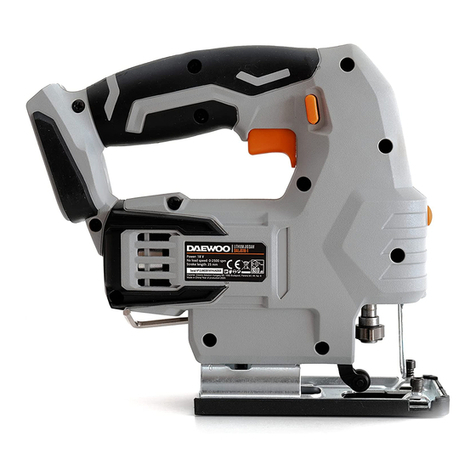
Daewoo
Daewoo DALJS18-1 user manual
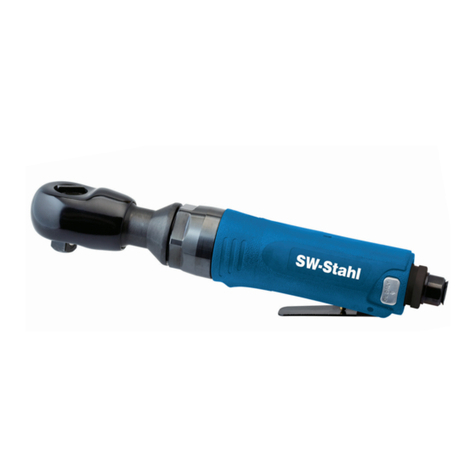
SW-Stahl
SW-Stahl S3283 instruction manual
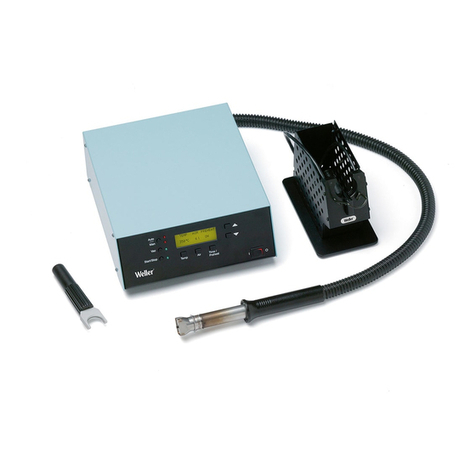
Weller
Weller WHA 3000VS operating instructions
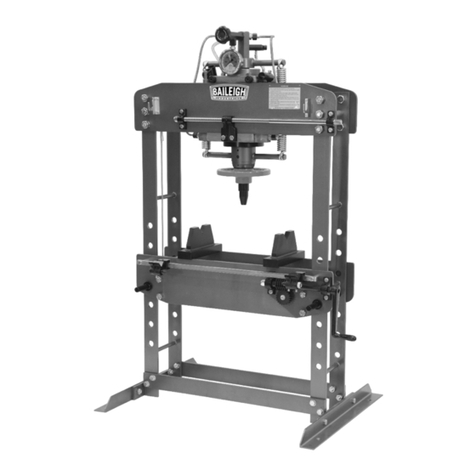
Baileigh Industrial
Baileigh Industrial HSP-5A Operating instructions and parts manual
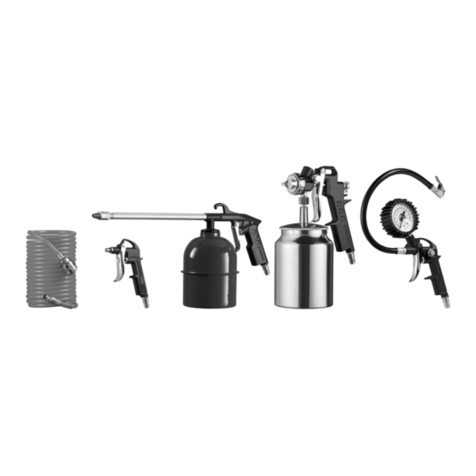
Parkside
Parkside PDLS 5 A1 Translation of the original instructions
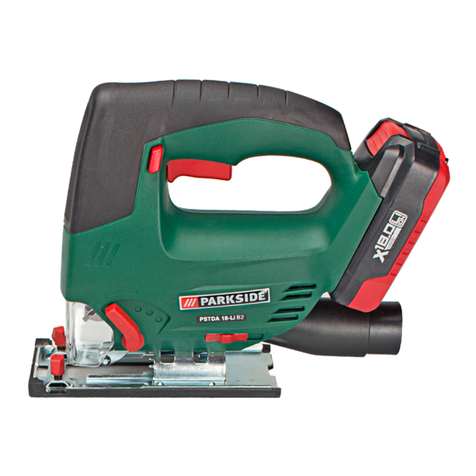
Parkside
Parkside PSTDA 18-Li B2 original operation manual



